Table of Contents
If you are an owner of a German Shepherd dog or going to acquire one, you may want to know what German Shepherd colors you can encounter, what your pet’s color means and what you can expect of it.
German Shepherds are often associated with the police force. They have a severe look and they are strong and brave. These dogs are also very obedient and loyal. They make excellent protectors and perfect family pets.
Since this breed’s most widely encountered color variation is black and tan, many people don’t even suspect that there are so many different colors of these dogs and many of them are quite unusual and rare.
Today, we are going to consider the primary GSD colors. Some of them correspond fully to the standards of the breed and some don’t.
Common and Original Colors
Though there are a lot of variations of German Shepherd colors, the original ones are sable, black, white, and grey. There are also certain variations of these colors that developed in the process of breeding or are caused by genetic modifications. The main colors accepted by international kennel associations are black and tan, black and red, bicolor, black, sable, and grey. Some organizations are ready to accept liver and tan as well as blue. They believe that the purity of the breed depends on the intensity of the color, so the diluted hues are not acceptable.
Black and Tan

This is the most widely encountered coat color for this breed. The pattern also matters. You may see the dogs with the saddleback and blanket back covering the dog’s back and sides. The ancestor dog bearing this color was Horand von Grafrath, who was a little darker than the present-day dogs. The breed was registered in the late 1800s.
This feature is recessive when mixed with sable but dominant when breeding with black and its variations. The puppies are usually born very dark and beginning with the 6th month they start to lighten up. The process finishes until the dog is two years old. Some female dogs have a gray stripe on their back that starts developing after two years. It is called a ‘bitch’s stripe’. Though black and tans are allowed in the show line, this color is usually seen in working lines.
Black and Red
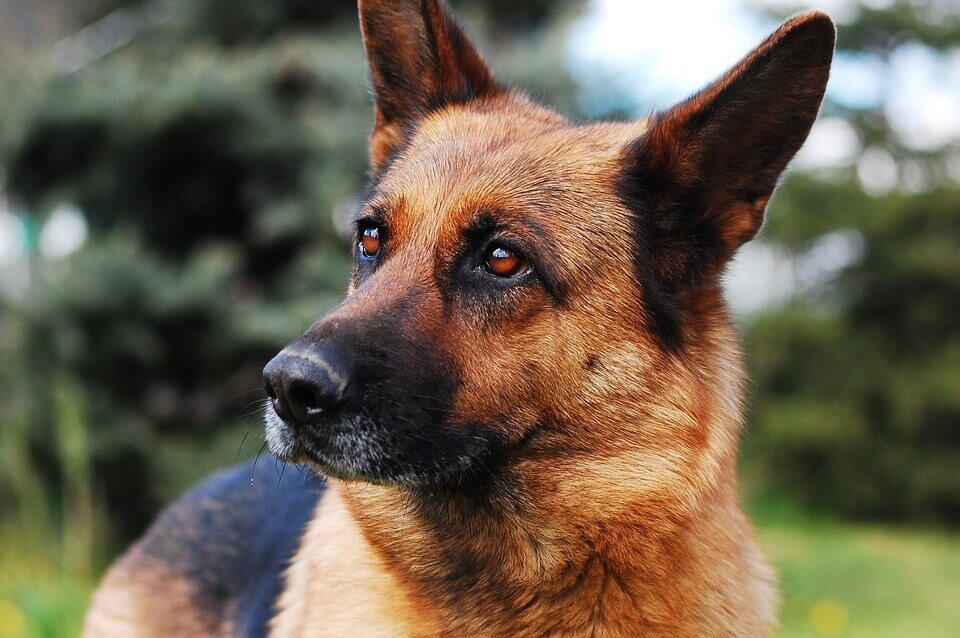
This is the most appreciated color for show lines. Though, it is considered to be a variation of black and tan. The tan is replaced here by the rich red though the pattern is the same as for black and tan dogs.
The black and red German Shepherd color gene pheomelanin influences the appearance of this variation. The shades of red can vary – from lighter strawberry blonde to darker and more intensive mahogany red.
Such a combination is mostly preferable for all the conformation shows and experienced breeders highly value it. That’s because the color is produced by the dominant genes, so such dogs are easier to breed.
Black and Silver
Once again, the common patterns of a saddleback and blanket-back are preserved here. A silver hue replaces only the tan or red. This coloration can appear when the recessive color suppression gene is present in one of the parents.
The variation is allowed for the show lines, but silver sable German Shepherd dogs are not quite common in them. You can encounter this coloring mostly in working lines. If you are an owner of such a dog, remember that it is not visible in the dark, so it needs a special collar for night walking.
Black and Cream
This is a lighter variation of black and tan and the last officially accepted type of coloring for the breed. However, since the breeders understand that conformation rules account for darker and more intensive colors, they do not eagerly display their dogs colored like this at the shows.
Sable

This is the original color of this breed and it is a dominant gene that develops it. This German Shepherd color looks very similar to a wild wolf. Every single hair has about three colors on its string, so such dogs are also called tri-colored. The tips of the hairs end with black. These colors can be of different hues – grey, tan, red, or dark brown. The dark shades are more preferable for show lines.
The sable gene should be present in at least one sample of the dog pair. It is a dominant gene and it never displays recessively. The two dogs, who are black and tan, cannot produce sable. When a sable color German Shepherd male is bred to a female of any color, their litter will be all sable. However, a puppy that was born sable may not be a dominant sable because it also receives a recessive gene of another color. The tri-color German Shepherd can change with age. The dogs become darker, or some of them can get even lighter. The color starts changing from 6 months and ends at the age of two years.
The first registered sample of this breed color was a female born in the end of the 1800s.
Bicolor

This is believed to be a variation of black and tan. In fact, the dog’s body is black though it has some little areas of tan, brown, or grey on its paws, around the eyebrows, or under the tail. It may also have some trace of another color on the cheeks. The true bicolor German Shepherd is very dark with just minimal spots of another color. When you need to see whether the puppy is bicolor just after its birth, you need to look for a brown spot under its tail.
Bicolor is a recessive gene to the common black and tan. Bicolors can be commonly met in working lines rather than in show lines.
Black
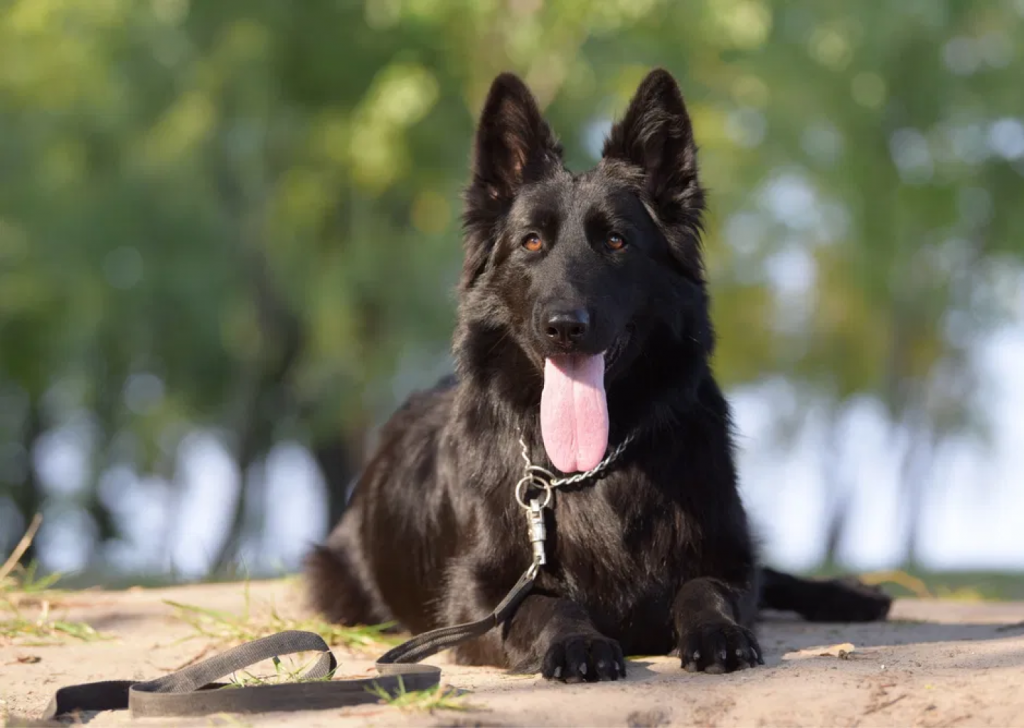
It is one of the initial colors for this breed. Such black German Shepherd dogs have a fully solid color. Some hairs can be a bit brownish, especially on their paws, or they may carry a white spot on their chest.
These dogs are not encountered so often as black and tan ones, but they are not considered rare. Black is caused by the most recessive color gene of all, so the litter of such a dog can be of any other color even if both parents are black. Though, the offspring all have this recessive gene. So, the subsequent litters of this breed can produce black shepherds quite unexpectedly.
White
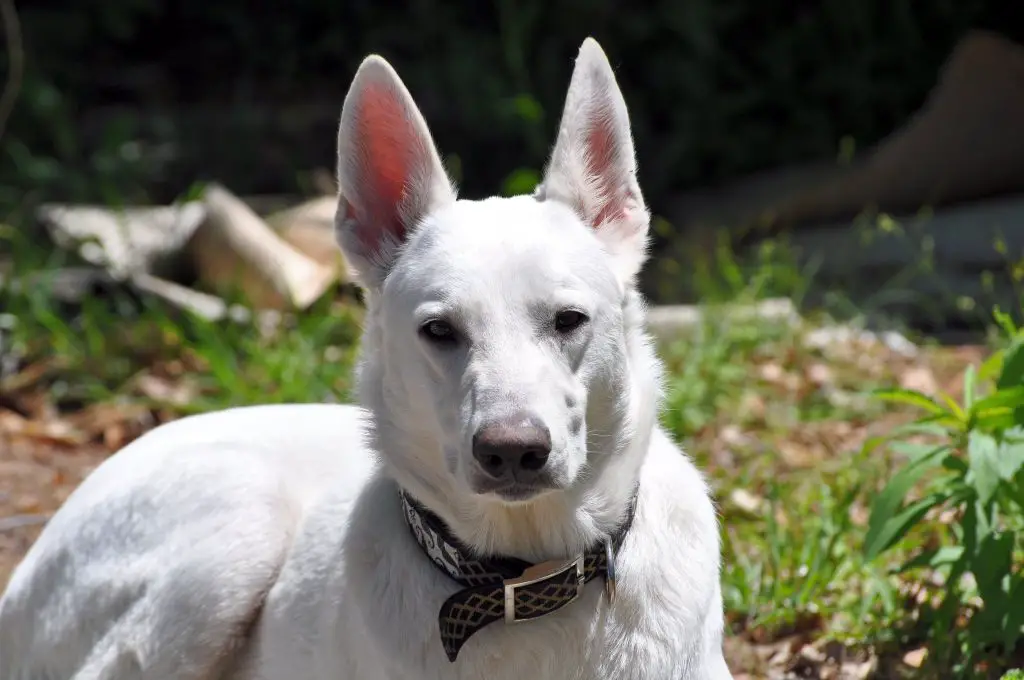
It may sound strange, but white is another original German Shepherd color, no matter what the breeder will tell you about its uniqueness. You may have seen white shepherds many times, but you didn’t realize that this dog belongs to this breed.
However, according to all breeding standards, white color in GSs is seen as a significant fault that disqualifies the puppy immediately. Such dogs are never shown in conformations and they are not allowed in any other shows. The AKC (the American Kennel Club), however, allows it for breeding.
Some people also believe that the white color is the lack of color and such dogs are often confused with albinos. In fact, they are not. The main difference between a white German Shepherd and an albino GS is the color of their eyes. In albinos, it is pinkish blue, reddish blue, or just red. White-colored Shepherds’ eyes are golden brown, hazel, or even blue. They also have some spots of other colors on their body, but albinos cannot have them because their body does not produce any color.
The gene that is responsible for the appearance of a white puppy in the litter of black and tans, sables, or blacks is called a masking gene meaning that the genetic color of such a pup is masked.
The white German Shepherd dogs are considered rare and there are special organizations that care about them and breeders strive for their promotion.
There are many other misconceptions about these white GSDs. Some people believe that they are the same as White Swiss Shepherd or some other dog breeds like an American-Canadian White Shepherd, but they aren’t.
Grey

Grey German Shepherds resemble wolves. That is why this variation is also called ‘wolf-grey’, or it is also known as Agouti. Though this color does not contain any others and there are no black tips in the hairs.
Grey is one of the six primary colors recognized by the AKC. This GSD color is caused by the dominant gene. One parent can have it to produce the grey offspring. The gene can also be present in dogs in a recessive form, but it should be present in both parents to receive a grey puppy.
The grey color in German Shepherds is not too rare but quite uncommon, so breeders do their best to breed puppies of this stunning color.
Silver
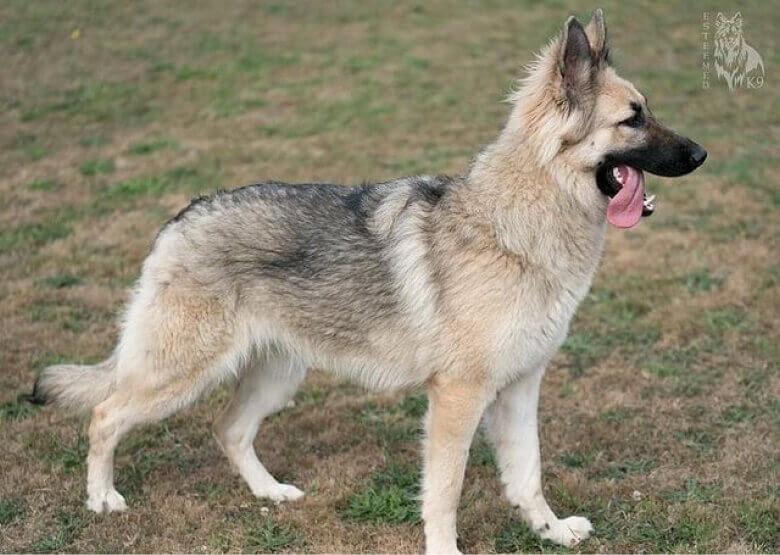
The same modification of genes produces silver and grey German Shepherd puppy colors. However, silver is recognized as a separate color. Unlike grey, silver is caused by a recessive gene that can affect the black pigment and dilute it. A silver German Shepherd can be widely seen in the police force and military service.
Rare Colors
Some colors of GSDs are truly rare. They look stunning and such dogs cost very much to acquire. Though they are not allowed for conformation shows, the experts believe that they can break the breed’s integrity.
Blue

These blue German Shepherd dogs do not have black in their coats. They display blue instead. This dog makes up a stunning sight. Its eyes are golden-brown or amber-colored and that provides an exotic look. A recessive dilution gene provides this German Shepherd color. The dogs may be mistaken for a Blue Belgian Malinois and its acceptance to the conformation shows is somewhat controversial. The AKC considers it inappropriate for the shows.
Light Blue
This light colored German Shepherd is a blue color variation. The difference is in traces of silver on the light blue dog’s back. While the AKC already accepts the blue GSDs, the light blue ones are not.
Isabella

This is the rarest color of GSDs’ fur. The color is produced by the combination of the two dilution genes – blue and liver ones. The color of the eyes is also quite unusual, as well as the color of the nose which can be of any hue from pink to liver.
The dog does not have any black pigmentation anywhere, even on the paw pads. Its eyes are either hazel or light blue.
Liver

In this coat color, black is replaced by deep brown. The classic liver covers all the body of a dog. It is a solid color without any hint of tan or anything else. This color is rare, but some people do not know about it and do not think their pets to be so unique. The liver colored German Shepherd dog has amber-colored eyes and looks very distinctive and gorgeous.
The gene that causes this color is recessive, so both parents need this gene in their DNA to produce the litter of this color.
The AKC accepts the GSDs colored like that though they are considered faulty and not corresponding completely to the breed’s standards.
Liver and Tan
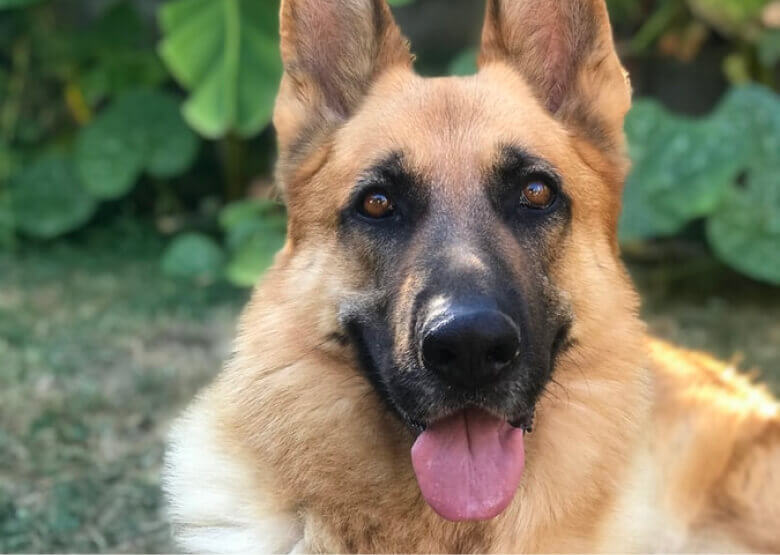
Again, this is a unique variation of a black and tan color. Instead of being black, the dog acquires this deep brownish color.
Panda

The unique pattern of a white German Shepherd color contains black spots on the body. Some people always argue that this is not an original genetic color, but such a panda colored German Shepherd dog is actually a crossbreed with a Border Collie.
In fact, the color is caused by a rare gene mutation and does not have anything in common with crossbreeding. This piebald gene is the cause of coloring 40 percent of the dog’s body in white.
The first representative of the breed bearing this color was Lewcinka’s Franka von Phenom. Though many people didn’t believe that she was not a crossbreed, her DNA test proved the purity of the German Shepherd breed.
Albino

This is considered extremely rare. Those people who claim that their dog is an albino German Shepherd are mistaken and just have a white-colored GS.
An albino representative of any species lacks pigmentation completely. There is no color on the skin, eyes, hair, or even on the blood vessels. When you look at the German Shepherd albino, pay attention to its eyes and nose. Albino’s eyes are red or pinkish and its nose is pinkish too. These dogs can suffer from some health conditions. For example, they are photosensitive, so they cannot withstand direct sunlight.
Some Misconceptions About the Colors of German Shepherd Dogs
Only experienced experts can differentiate all the colors and hues of this stunning breed. That produces many misconceptions and wrong ideas about these dogs. So, let’s discuss some of them.
Black and Tan and Black and Red Are Not the Same
People usually think that black and tan GSDs are what they exactly should look like because they associate them with the police dogs featured in the films. However, they cannot distinguish between black and tan and black and red, thinking that it is the same coloring. It is not, of course. The black and cream and black and silver colors are not similar, either.
Mythology Around Black German Shepherds
While breeders usually claim that black and black sable German Shepherd dogs are much stronger and more agile than other colors, common people still believe that meeting such a dog at night is a bad omen. The owners also argue that their black dog’s coat is softer and more luxurious. Also, some people are afraid of these dogs more than others because they think they are more aggressive. However, the color does not influence the dog’s behavior. Its breeding and ways of training are the factors that really matter.
Rare-colored German Shepherd Dogs Do Not Have Health Problems
This misconception is widely spread referring to white dogs. They are believed to be deaf. Others claim that rare-colored dogs are more susceptible to infections and their lifespan is much shorter than those who have more common colors. Be sure that the dog’s health does not depend on the color of their coat. German Shepherds belong to a large breed and they are vulnerable to such disorders as hip or shoulder dysplasia or bloating, but these diseases do not correlate with the color of their fur.
The Color Does Not Influence the Behavior
As it has just been said about the black dogs, other colors do not affect the animal’s behavior, either. The dog’s temperament is predetermined by the characteristics of the breed, care, and training. All German Shepherd colors possess such qualities as obedience, calmness, readiness to defend and protect, and alertness. Or they may be aggressive and even dangerous if not trained and cared for properly.
Final Thoughts
Before adopting a German Shepherd dog, think about your preferences, mostly why you want to have this dog. There are some requirements if you want it to be presented in the show ring. You need to think about the German Shepherd puppy colors and shades then. Or you may just want your dog to protect your house and family. In this case, any hue of the coating is suitable. If you want your German Shepherd just to be a family pet and companion, you may follow your personal preferences.
Take your GSD puppy from a reputable breeder who can guarantee the purity of the breed and the excellent physical qualities of the parents and their litter. Your dog will become an excellent investment then.
We hope that speaking so much about the GSD colors as we have done in this article will help you in making your choice. Or, if you are already a happy owner of this stunning pet, you might have learned many interesting things that will help you take care of your beloved fido in the future.

